Spatial Assessment of Cancer Incidences and the Risks of Industrial Wastewater Emission in China
Abstract
:1. Introduction
2. Methodology
2.1. Analytical Framework
2.2. Study Area
2.3. Data and Data Sources
2.4. Methods
3. Results and Discussion
3.1. Spatial-Temporal Variations of Cancer Incidences and Industrial Pollution
3.2. Socioeconomic Transitions, Industrial Pollutions, and Human Health
4. Conclusions
Acknowledgments
Author Contributions
Conflicts of Interest
Abbreviations
| As | Arsenic |
| Cd | Cadmium |
| Cr | Chromium |
| Hg | Mercury |
| Pb | Lead |
| IARC | International Agency for Research on Cancer |
| USEPA | U.S. Environmental Protection Agency |
| Igeo | geo-accumulation index |
| TVEs | Township and Village Enterprises |
| MNCs | multinational corporations |
| TBL | trachea/bronchus/lung |
| IWWI | industrial wastewater index |
| IND | industrialization, the percentage of the annual industrial output out of the total GDP |
| MQ | mining and quarrying, the percentage of persons employed in mining and quarrying |
| TRA | transportation, road density |
| URB | urbanization, population density |
| AGR | agriculture, the percentage of the annual agricultural output from the total GDP |
| GLO | Globalization, foreign direct investment per capita |
| ECO | economic development, GDP per capita |
| HYD | hydrology properties |
| DIS | the distance of a city to a major water body |
| GRE | green area coverage |
| STR | the sewage treatment rate |
| TPOP | total population |
| VIFs | variance inflation factors |
| LPG factories | Liquified Petroleum Gas factories |
References
- Schwarzenbach, R.P.; Egli, T.; Hofstetter, T.B.; Von Gunten, U.; Wehrli, B. Global water pollution and human health. Annu. Rev. Environ. Resour. 2010, 35, 109–136. [Google Scholar] [CrossRef]
- Li, H.; Li, Y.; Lee, M.K.; Liu, Z.; Miao, C. Spatiotemporal analysis of heavy metal water pollution in transitional China. Sustainability 2015, 7, 9067–9087. [Google Scholar] [CrossRef]
- Wang, Y.; Wang, P.; Bai, Y.; Tian, Z.; Li, J.; Shao, X.; Mustavich, L.F.; Li, B.-L. Assessment of surface water quality via multivariate statistical techniques: A case study of the Songhua River Harbin region, China. J. Hydro-Environ. Res. 2013, 7, 30–40. [Google Scholar] [CrossRef]
- Liu, L. Made in China: Cancer villages. Environ. Sci. Policy Sust. Dev. 2010, 52, 8–21. [Google Scholar] [CrossRef]
- Sarkar, B. Heavy Metals in the Environment; CRC Press: Boca Raton, FL, USA, 2002. [Google Scholar]
- Hu, H.; Jin, Q.; Kavan, P. A study of heavy metal pollution in China: Current status, pollution-control policies and countermeasures. Sustainability 2014, 6, 5820–5838. [Google Scholar] [CrossRef]
- Duruibe, J.O.; Ogwuegbu, M.O.C.; Egwurugwu, J.N. Heavy metal pollution and human biotoxic effects. Int. J. Phys. Sci. 2007, 2, 112–118. [Google Scholar]
- Morais, S.; E-Costa, F.G.; De Lourdes Pereira, M. Heavy Metals and Human Health; InTech Open Access Publisher: Rijeka, Croatia, 2012. [Google Scholar]
- Liu, Y.; Chen, M.; Jiang, L.; Song, L. New insight into molecular interaction of heavy metal pollutant—Cadmium (II) with human serum albumin. Environ. Sci. Pollut. Res. 2014, 22, 6994–7005. [Google Scholar] [CrossRef] [PubMed]
- IARC Working Group on the Evaluation of Carcinogenic Risks to Humans; World Health Organization; International Agency for Research on Cancer. Some Drinking-Water Disinfectants and Contaminants, Including Arsenic; IARC: Lyon, France, 2004; Volume 84. [Google Scholar]
- Dauphiné, D.C.; Smith, A.H.; Yuan, Y.; Balmes, J.R.; Bates, M.N.; Steinmaus, C. Case-control study of arsenic in drinking water and lung cancer in California and Nevada. Int. J. Environ. Res. Public Health 2013, 10, 3310–3324. [Google Scholar] [CrossRef] [PubMed]
- Oberoi, S.; Barchowsky, A.; Wu, F. The global burden of disease for skin, lung, and bladder cancer caused by arsenic in food. Cancer Epidemiol. Biomark. Prev. 2014, 23, 1187–1194. [Google Scholar] [CrossRef] [PubMed]
- Meng, W.; Qin, Y.; Zheng, B.; Zhang, L. Heavy metal pollution in Tianjin Bohai bay, China. J. Environ. Sci. 2008, 20, 814–819. [Google Scholar] [CrossRef]
- Wang, M.M.; Webber, B.F.; Barnett, J. Rural industries and water pollution in China. Environ. Manag. 2008, 86, 648–659. [Google Scholar] [CrossRef] [PubMed]
- Zhai, L.; Liao, X.; Chen, T.; Yan, X.; Xie, H.; Wu, B.; Wang, L. Regional assessment of cadmium pollution in agricultural lands and the potential health risk related to intensive mining activities: A case study in Chenzhou City, China. J. Environ. Sci. 2008, 20, 696–703. [Google Scholar] [CrossRef]
- Liu, J.; Zhang, X.-H.; Tran, H.; Wang, D.-Q.; Zhu, Y.-N. Heavy metal contamination and risk assessment in water, paddy soil, and rice around an electroplating plant. Environ. Sci. Pollut. Res. 2011, 18, 1623–1632. [Google Scholar] [CrossRef] [PubMed]
- Zhou, Y.; Fu, S.; Zhang, C.; Chen, B.; Yang, X. Geochemical environmental effects of metallic sulfide deposits and its mining and origin of cancer village in Dabaoshan from northern Guangdong (China). Environ. Monit. Assess. 2008, 184, 2261–2273. [Google Scholar]
- Zhou, Y.; Fu, S.; Zhang, C.; Chen, B.; Yang, Z.; Yang, X. Geochemical migration model of heavy metal elements in eco-environmental system of sulfide-bearing metal mines in South China; specific discussion on Dabashan Fe-Cu-polymetallic mine, Guandong. Earth Sci. Front. 2008, 15, 248–255. [Google Scholar]
- Kerger, B.D.; Butler, W.J.; Paustenbach, D.J.; Zhang, J.; Li, S. Cancer mortality in Chinese populations surrounding an alloy plant with chromium smelting operations. J. Toxicol. Environ. Health Sci. Part A 2009, 72, 329–344. [Google Scholar] [CrossRef] [PubMed]
- Bale, R. China’s Other Pollution Problem-Its Soil. The Center for Investigative Reporting. 2014. Available online: http://www.environmentmagazine.org/Archives/Back%20Issues/March-April%202010/made-in-china-full.html (accessed on 25 October 2014).
- Tan, D. Heavy Metals & Agriculture. China Water Risk Review. 2014. Available online: http://chinawaterrisk.org/resources/analysis-reviews/heavy-metals-agriculture/ (accessed on 30 July 2015).
- Liu, J.; Diamond, J. China’s environment in a globalizing world. Nature 2005, 435, 1179–1186. [Google Scholar] [CrossRef] [PubMed]
- Hu, Y.; Cheng, H. Water pollution during China’s industrial transition. Environ. Dev. 2013, 8, 57–73. [Google Scholar] [CrossRef]
- Li, Z.; Ma, Z.; van der Kuijp, T.J.; Yuan, Z.; Huang, L. A review of soil heavy metal pollution from mines in China: Pollution and health risk assessment. Sci. Total Environ. 2014, 468, 843–853. [Google Scholar] [CrossRef] [PubMed]
- Chen, H.; Lu, X.; Chang, Y.; Xue, W. Heavy metal contamination in dust from kindergartens and elementary schools in Xi’an, China. Environ. Earth Sci. 2014, 71, 2701–2709. [Google Scholar] [CrossRef]
- Jiang, D.; Hu, Z.; Liu, F.; Zhang, R.; Duo, B.; Fu, J.; Cui, Y.; Li, M. Heavy metals levels in fish from aquaculture farms and risk assessment in Lhasa, Tibetan Autonomous Region of China. Ecotoxicology 2014, 23, 577–583. [Google Scholar] [CrossRef] [PubMed]
- World Bank. Water Quality Management Policy and Institutional Considerations; World Bank: Washington, DC, USA, 2006. [Google Scholar]
- Ebenstein, A. The consequences of industrialization: Evidence from water pollution and digestive cancers in China. Rev. Econ. Stat. 2012, 94, 186–201. [Google Scholar] [CrossRef]
- Ministry of Water Resources of China (MWR). China Water Resources Bulletin; China Ministry of Water Resources: Beijing, China, 2012.
- Geng, Y.; Wang, M.; Sarkis, J.; Xue, B.; Zhang, L.; Fujita, T.; Yu, X.; Ren, W.; Zhang, L.; Dong, H. Spatial-temporal patterns and driving factors for industrial wastewater emission in China. J. Clean. Prod. 2014, 76, 116–124. [Google Scholar] [CrossRef]
- Carr, R.; Zhang, C.; Moles, N.; Harder, M. Identification and mapping of heavy metal pollution in soils of a sports ground in Galway City, Ireland, using a portable XRF analyser and GIS. Environ. Geochem. Health 2008, 30, 45–52. [Google Scholar] [CrossRef] [PubMed]
- Kendy, E.; Zhang, Y.; Liu, C.; Wang, J.; Steenhuis, T. Groundwater recharge from irrigated cropland in the North China Plain: Case study of Luancheng County, Hebei Province, 1949–2000. Hydrol. Process. 2004, 18, 2289–2302. [Google Scholar] [CrossRef]
- Ministry of Environmental Protection (MEP). The State of the Environment of China in 2008. Available online: http://english.mep.gov.cn/News_service/news_release/200906/t20090618_152932.htm (accessed on 10 January 2016).
- Gong, P.; Liang, S.; Carlton, E.J.; Jiang, Q.; Wu, J.; Wang, L.; Remais, J.V. Urbanization and health in China. Lancet 2012, 379, 843–852. [Google Scholar] [CrossRef]
- Yearbook, C.S. China Statistical Yearbook; China Statistics Press: Beijing, China, 2015. [Google Scholar]
- Wei, Y.D. Beyond new regionalism, beyond global production networks: Remaking the Sunan model, China. Environ. Plan. C Gov. Policy 2010, 28, 72–96. [Google Scholar] [CrossRef]
- Yang, Q.L.; Li, W.D. Current issues on occupational health and control strategies. China Occup. Med. 2004, 31, 58–59. (In Chinese) [Google Scholar]
- Yang, T.; Liu, J. Health Risk Assessment and Spatial Distribution Characteristic on Heavy Metals Pollution of Haihe River Basin. J. Environ. Anal Toxicol. 2012. [Google Scholar] [CrossRef]
- Walter, I. Environmentally induced industrial relocation to developing countries. Environ. Trad. 1982, 2, 235–256. [Google Scholar]
- He, C.; Huang, Z.; Ye, X. Spatial heterogeneity of economic development and industrial pollution in urban China. Stoch. Environ. Res. Risk Assess. 2014, 28, 767–781. [Google Scholar] [CrossRef]
- Drezner, D. Bottom Feeders. Foreign Policy 2000, 122, 64–73. [Google Scholar] [CrossRef]
- Christmann, P.; Taylor, G. Globalization and the environment: Determinants of firm self-regulation in China. J. Int. Bus. Stud. 2001, 32, 439–458. [Google Scholar] [CrossRef]
- Liu, Z.; Li, Y.; Li, Z. Surface water quality and land use in Wisconsin, USA–a GIS approach. J. Integr. Environ. Sci. 2009, 6, 69–89. [Google Scholar] [CrossRef]
- Peplow, D. Environmental Impacts of Mining in Eastern Washington; University of Washington Water Center: Seattle, WA, USA, 1999. [Google Scholar]
- Garbarino, J.R.; Hayes, H.; Roth, D.; Antweider, R.; Brinton, T.I.; Taylor, H. Contaminants in the Mississippi River. Available online: http://pubs.usgs.gov/circ/circ1133/heavy-metals.html (accessed on 30 April 2016).
- Wang, S.; Xu, X.; Sun, Y.; Liu, J.; Li, H. Heavy metal pollution in coastal areas of South China: A review. Mar. Pollut. Bull. 2013, 76, 7–15. [Google Scholar] [CrossRef] [PubMed]
- Li, Y.; Wei, D.Y. The spatial-temporal hierarchy of regional inequality of China. Appl. Geogr. 2010, 30, 303–316. [Google Scholar] [CrossRef]
- Li, Y.; Wei, Y.D. Multidimensional inequalities in health care distribution in provincial China: A case study of Henan Province. Tijdschr. Voor Econ. Soc. Geogr. 2014, 105, 91–106. [Google Scholar] [CrossRef]
- China Data Center. Available online: http://chinadatacenter.org/ (accessed on 5 December 2015).
- IPE. Institution of Public & Environmental Affairs. Available online: http://www.ipe.org.cn/pollution/status.aspx (accessed on 27 January 2016).
- Li, X.; Cheng, G.; Lu, L. Spatial analysis of air temperature in the Qinghai-Tibet Plateau. Arct. Antarct. Alp. Res. 2005, 37, 246–252. [Google Scholar] [CrossRef]
- Yang, J.S.; Wang, Y.Q.; August, P.V. Estimation of land surface temperature using spatial interpolation and satellite-derived surface emissivity. J. Environ. Inform. 2004, 4, 37–44. [Google Scholar] [CrossRef]
- Simasuwannarong, B.; Satapanajaru, T.; Khuntong, S.; Pengthamkeerati, P. Spatial distribution and risk assessment of As, Cd, Cu, Pb, and Zn in topsoil at Rayong Province, Thailand. Water Air Soil Pollut. 2012, 223, 1931–1943. [Google Scholar] [CrossRef]
- Wu, T.; Li, Y. Spatial interpolation of temperature in the United States using residual kriging. Appl. Geogr. 2013, 44, 112–120. [Google Scholar] [CrossRef]
- Gramatica, P. Principles of QSAR models validation: Internal and external. QSAR Comb. Sci. 2007, 26, 694–701. [Google Scholar] [CrossRef]
- Agunwamba, J.C. Analysis of socioeconomic and environmental impacts of waste stabilization pond and unrestricted wastewater irrigation: Interface with maintenance. Environ. Manag. 2001, 27, 463–476. [Google Scholar] [CrossRef] [PubMed]
- Beaumont, J.J.; Sedman, R.M.; Reynolds, S.D.; Sherman, C.D.; Li, L.H.; Howd, R.A.; Sandy, M.S.; Zeise, L.; Alexeeff, G.V. Cancer mortality in a Chinese population exposed to hexavalent chromium in drinking water. Epidemiology 2008, 19, 12–23. [Google Scholar] [CrossRef] [PubMed]
- Watts, J. China’s environmental health challenges. Lancet 2008, 372, 1451–1452. [Google Scholar] [CrossRef]
- Lu, Y.; Song, S.; Wang, R.; Liu, Z.; Meng, J.; Sweetman, A.J.; Jenkins, A.; Ferrier, R.C.; Li, H.; Luo, W.; et al. Impacts of soil and water pollution on food safety and health risks in China. Environ. Int. 2015, 77, 5–15. [Google Scholar] [CrossRef] [PubMed]
- Gleick, P.H. China and water. In The World’s Water 2008–2009: The Biennial Report on Freshwater Resources; Island Press: Washington, DC, USA, 2009; pp. 79–100. [Google Scholar]
- Shao, M.; Tang, X.; Zhang, Y.; Li, W. City clusters in China: Air and surface water pollution. Front. Ecol. Environ. 2006, 4, 353–361. [Google Scholar] [CrossRef]
- Chatterjee, S.; Hadi, A.S. Regression Analysis by Example; John Wiley & Sons: New York, NY, USA, 2013. [Google Scholar]
- Wen, M.; Browning, C.R.; Cagney, K.A. Poverty, affluence, and income inequality: neighborhood economic structure and its implications for health. Soc. Sci. Med. 2003, 57, 843–860. [Google Scholar] [CrossRef]
- Jarup, L. Hazards of heavy metal contamination. Br. Med. Bull. 2003, 68, 167–182. [Google Scholar] [CrossRef]
- Risher, J.R.; De Woskin, R. Toxicological Profile for Mercury (Update); US Deptartment Health & Human Services: Washington, DC, USA, 1999; p. 619.
- Ye, W.T. Behind the deadly GDP: Investigating Jiangsu Yancheng cancer village and industrial chemical pollution. Village Townsh. Forum. 2006, 40–41. (In Chinese) [Google Scholar]
- Li, Y.; Liu, J.; Cao, Z.; Lin, C.; Yang, Z. Spatial distribution and health risk of heavy metals and polycyclic aromatic hydrocarbons (PAHs) in the water of the Luanhe River Basin, China. Environ. Monit. Assess. 2010, 163, 1–13. [Google Scholar] [CrossRef] [PubMed]
- Li, Y.; Wei, D.Y. A spatial-temporal analysis of health care and mortality inequalities in China. Eurasian Geogr. Econ. 2010, 51, 767–787. [Google Scholar] [CrossRef]
- Gong, G.; Zhang, T. Temporal–spatial distribution changes of cancer village in China. China Popul. Resour. Environ. 2013, 23, 156–164. (In Chinese) [Google Scholar]
- Zhang, X.; Zhuang, D.; Ma, X.; Jiang, D. Esophageal cancer spatial and correlation analyses: Water pollution, mortality rates, and safe buffer distances in China. J. Geogr. Sci. 2014, 24, 46–58. [Google Scholar] [CrossRef]
- Feng, J.; Zhao, J. Spatial distribution and controlling factors of heavy metals contents in paddy soil and crop grains of rice–wheat cropping system along highway in East China. Environ. Geochem. Health 2012, 34, 605–614. [Google Scholar] [CrossRef] [PubMed]
- Wang, W.C.; Xu, D.M.; Chau, K.W.; Lei, G.J. Assessment of river water quality based on theory of variable fuzzy sets and fuzzy binary comparison method. Water Resour. Manag. 2014, 28, 4183–4200. [Google Scholar] [CrossRef]
- Zhao, M.Y.; Cheng, C.T.; Chau, K.W.; Li, G. Multiple criteria data envelopment analysis for full ranking units associated to environment impact assessment. Int. J. Environ. Pollut. 2006, 28, 448–464. [Google Scholar] [CrossRef]
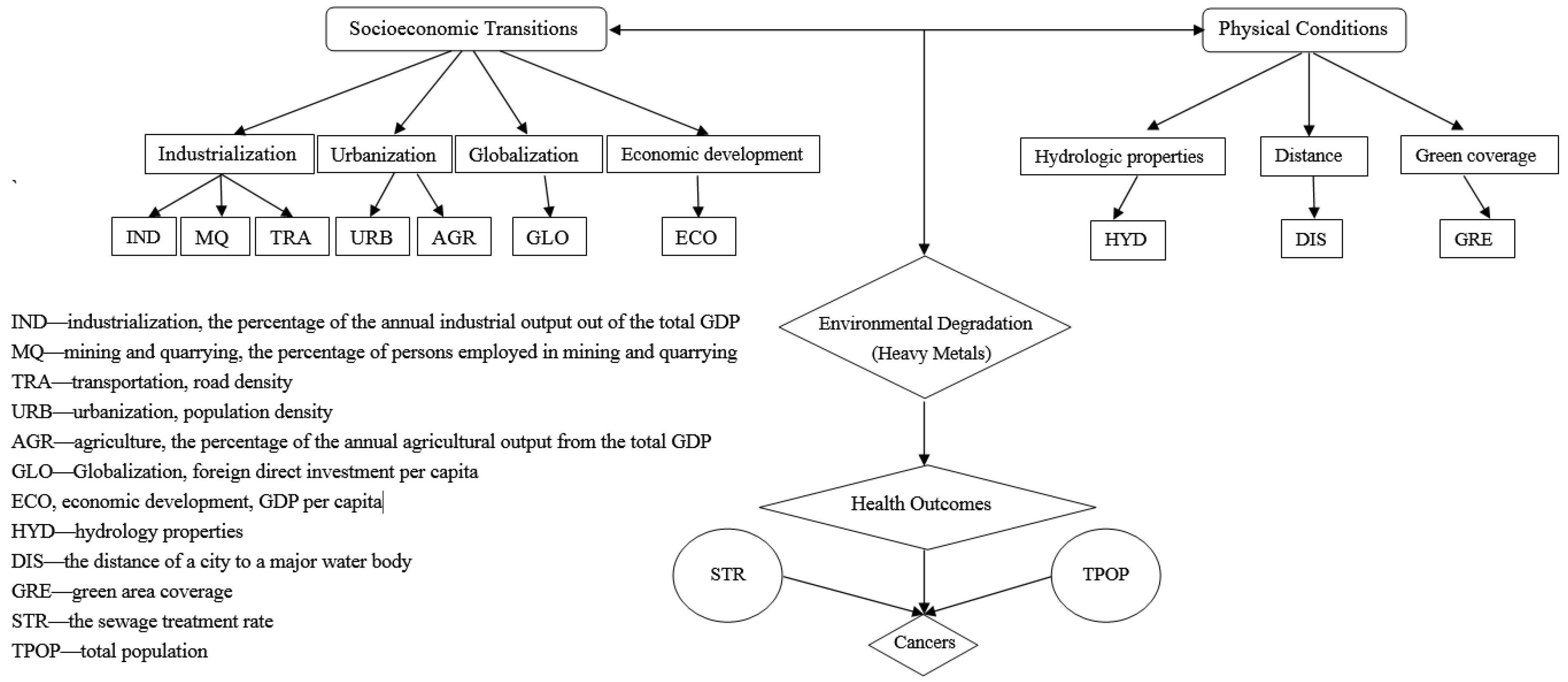

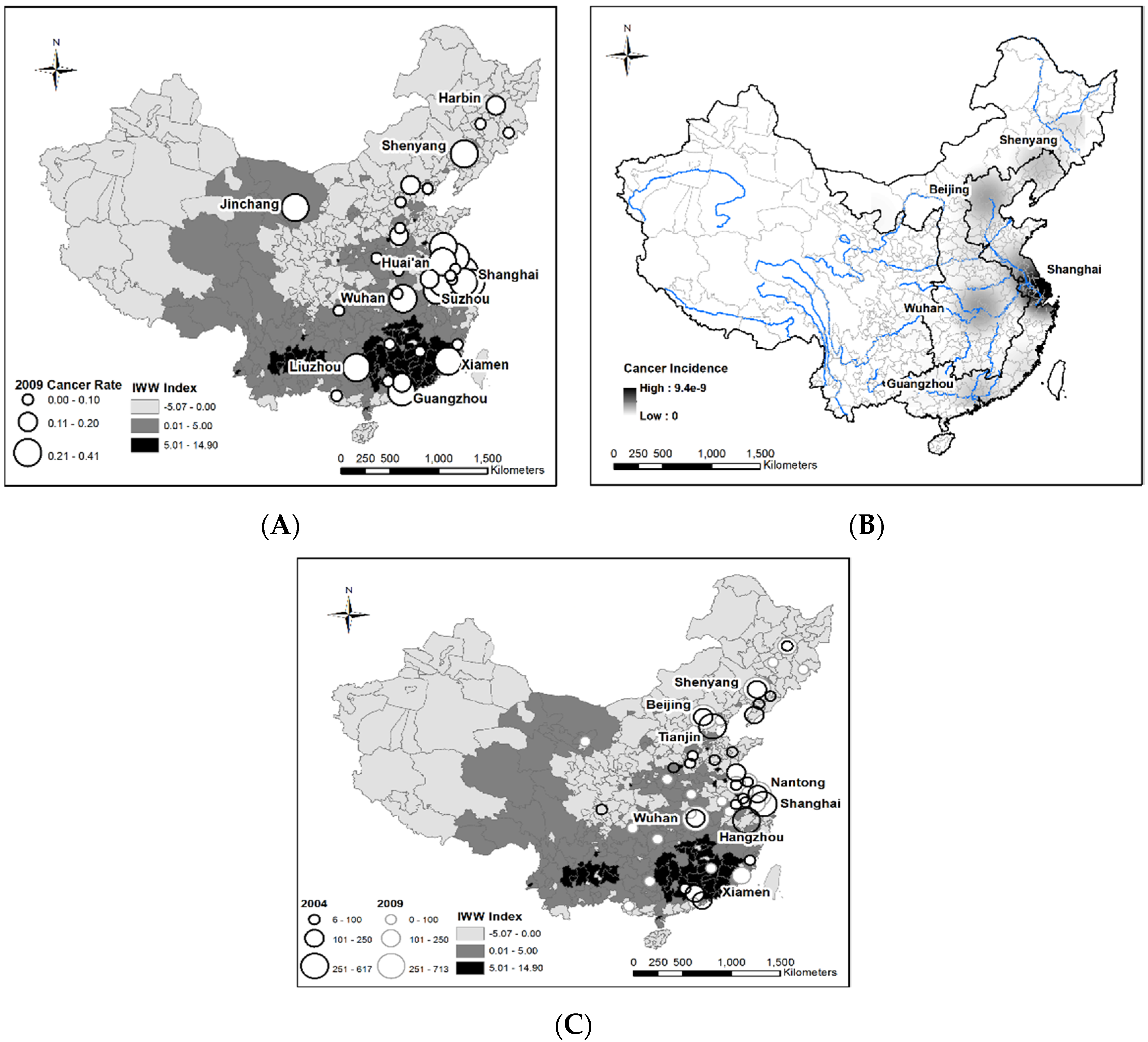

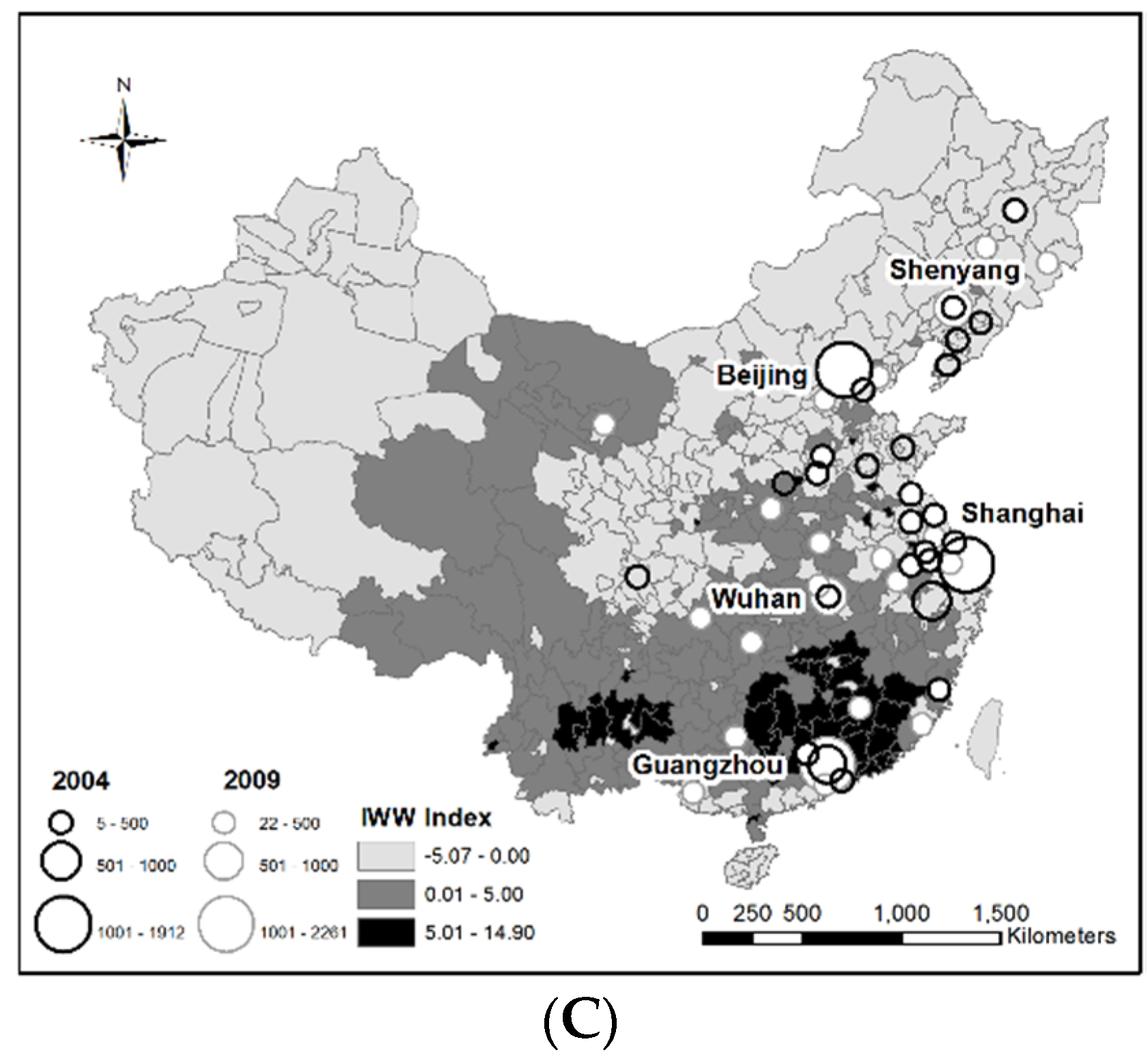
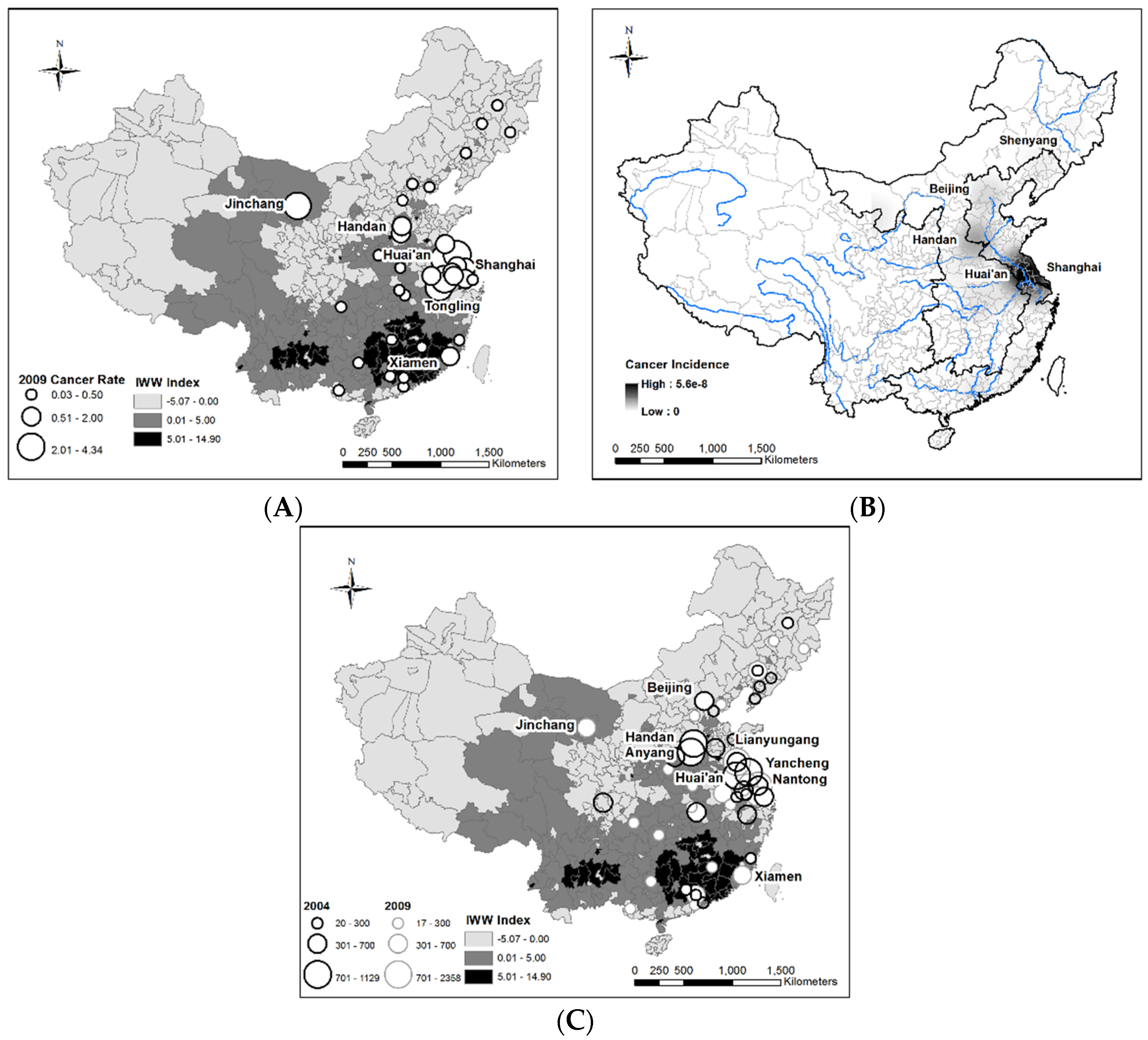
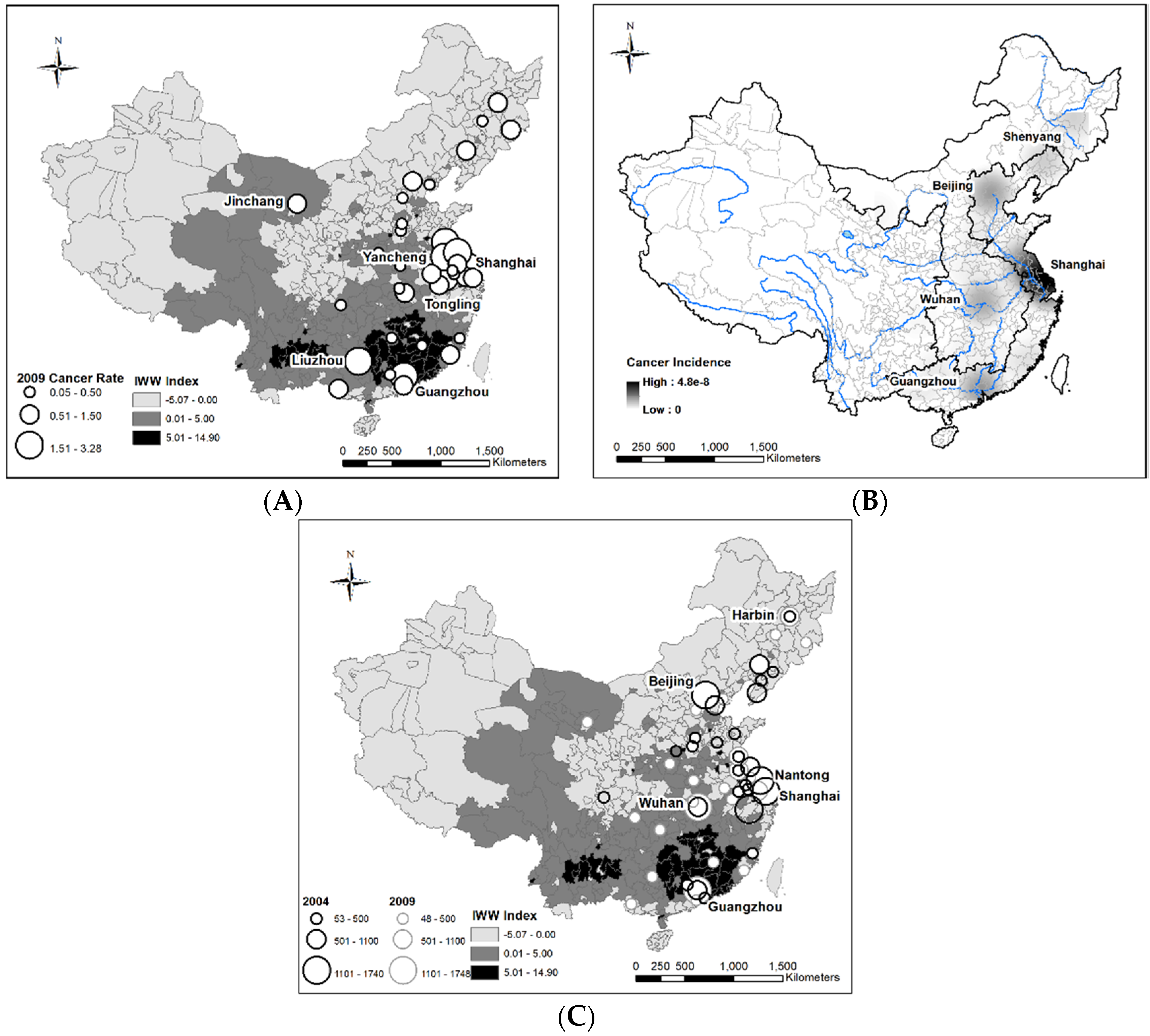

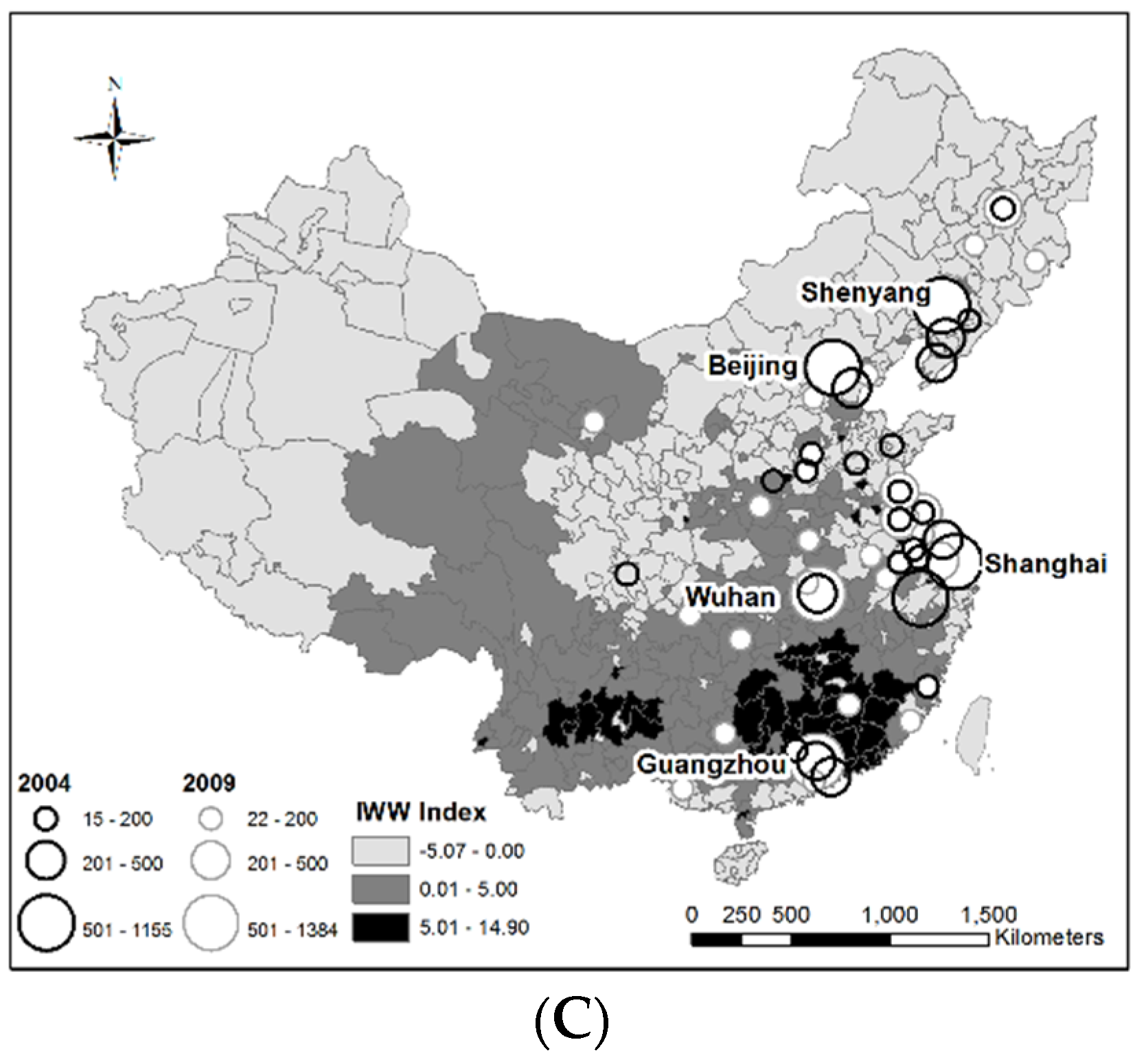


| Classes | Variables | Indicators | |
|---|---|---|---|
| Dependent variable | Cancer diseases | Number of registered cancer patients | |
| Independent variables | Socioeconomic transitions | Industrialization | Industrialization: Industrial output (IND); % of population employed in mining and quarrying (MQ), highway/railway density (TRA) |
| Urbanization | Population density (URB) Agricultural output (AGR) | ||
| Globalization | Foreign direct investment (GLO) | ||
| Economic development | GDP per capita (ECO) | ||
| Physical conditions | Green land | Percentage of green area (GRE) | |
| Hydrology | Upper, middle, and lower reaches (HYD) | ||
| Distance | Distance to a major water body (DIS) | ||
| Heavy metals | Untreated discharged As, Cr, Hg, Cd, and Pb (HM) | ||
| Sewage treatment rate | % of discharged treated polluted water (STR) | ||
| Total population | Total population (TPOP) | ||
| Independent Variables | Coefficients (Esophagus) | Coefficients (Stomach) | Coefficients (Colon) | Coefficients (Rectum) | Coefficients (Liver) | Coefficients (TBL) | Coefficients (BN) | |
|---|---|---|---|---|---|---|---|---|
| Control Variables | Intercept | 619.62 * | 1107.07 *** | 367.00 * | 301.74 * | 683.71 ** | 0.65 | 1006.42 |
| Sewage Treatment Rate (STR) | −5.81 ** | −4.40 ** | 0.44 | −0.04 | −0.18 | 0.01 | 0.35 | |
| Heavy Metals | Pb | −251.61 | −489.96 | −101.21 | −135.77 | −254.42 | 2.24 ** | −450.86 |
| Cr | 9.45 | −10.47 | 99.02 | 40.82 | 160.08 | 0.09 | 143.90 | |
| Hg | 12,576.35 | 16,673.68 ** | −3517.43 | 3029.35 | 11,190.96 * | −2.67 | 12,385.53 | |
| Cd | 488.89 | 718.44 | −346.31 | −120.41 | −309.57 | −6.93 *** | −626.10 | |
| Socioeconomic Transitions | Urbanization (URB) | 0.25 | −0.09 | 0.07 | 0.05 | 0.04 | 0.001 | 0.07 |
| Agricultural (AGR) | −1.37 | −3.55 *** | −1.88 ** | −1.37 ** | −1.60 | −0.01 ** | −3.77 | |
| Industrialization (IND) | −0.02 | 0.51 *** | 0.37 *** | 0.24 *** | 0.25* | 0.00 | 0.76 ** | |
| Transportation (TRA) | −88.58 | −109.23 | −136.38 | −176.97 * | −213.02 | −0.92 * | −667.05 | |
| Employment (MQ) | −700.45 | −796.11 | −376.65 | −409.56 | −918.27 | 6.25 ** | −1787.92 | |
| Economic Development (ECO) | −0.002 | −0.013 * | −0.01 ** | −0.01 * | −0.01 | 0.00 | −0.21 | |
| Physical Conditions | Distance (DIS) | −189.63 | −107.54 | 320.22 * | 239.31* | 252.47 | 1.38 ** | 917.92 * |
| Hydrology (HYD) | 324.80 ** | 229.16 * | −98.05 | −12.91 | 53.08 | 0.56 | −75.63 | |
| Green Coverage Rate (GRE) | 7.87 | 9.97* | 3.97 | 3.95 | 3.54 | 0.01 | 15.96 | |
| Significance F | 0.129 | 0.001 *** | 0.000 *** | 0.001 *** | 0.008 *** | 0.01 *** | 0.012 ** | |
| R-square | 0.55 | 0.77 | 0.84 | 0.76 | 0.70 | 0.69 | 0.68 |
© 2016 by the authors; licensee MDPI, Basel, Switzerland. This article is an open access article distributed under the terms and conditions of the Creative Commons Attribution (CC-BY) license (http://creativecommons.org/licenses/by/4.0/).
Share and Cite
Li, Y.; Li, H.; Liu, Z.; Miao, C. Spatial Assessment of Cancer Incidences and the Risks of Industrial Wastewater Emission in China. Sustainability 2016, 8, 480. https://doi.org/10.3390/su8050480
Li Y, Li H, Liu Z, Miao C. Spatial Assessment of Cancer Incidences and the Risks of Industrial Wastewater Emission in China. Sustainability. 2016; 8(5):480. https://doi.org/10.3390/su8050480
Chicago/Turabian StyleLi, Yingru, Huixuan Li, Zhongwei Liu, and Changhong Miao. 2016. "Spatial Assessment of Cancer Incidences and the Risks of Industrial Wastewater Emission in China" Sustainability 8, no. 5: 480. https://doi.org/10.3390/su8050480





